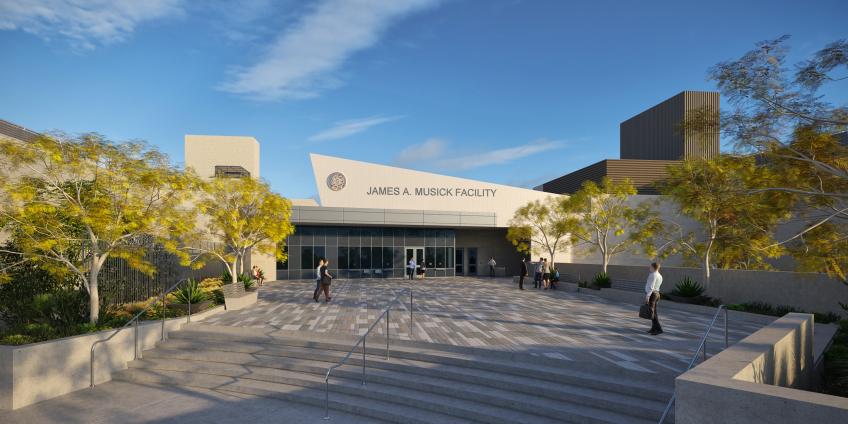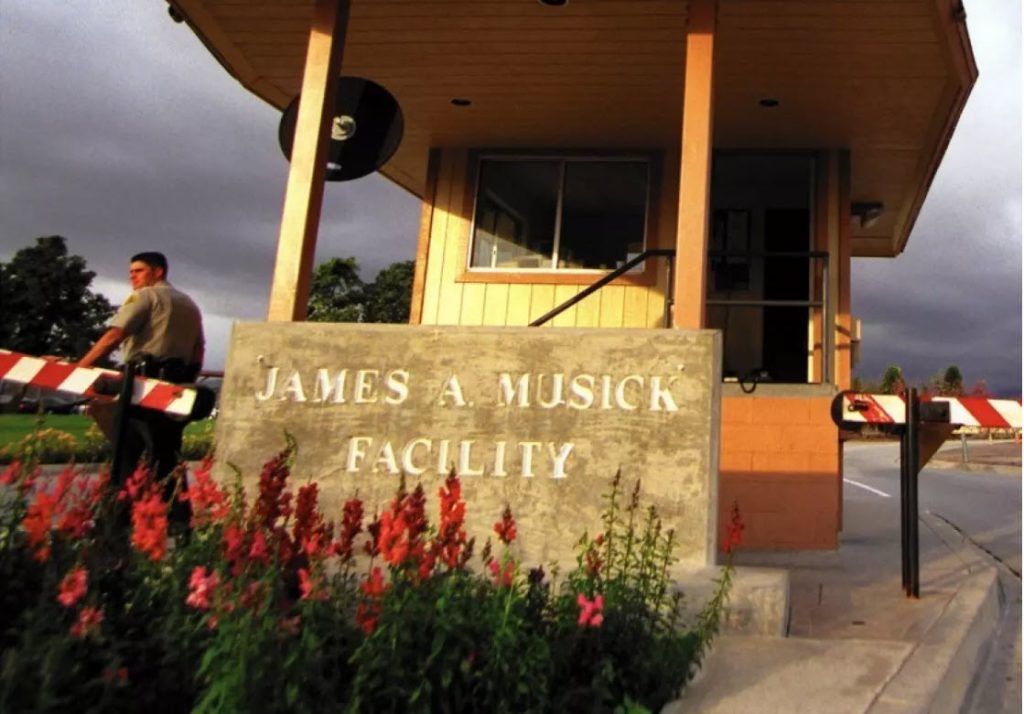
This will be the third installment of the ongoing series of posts about Orange County jails. The third jail in the Orange County Jail system is the James Musick Facility, also known as The Farm. James Musick was an interesting guy!
Musick is a one hundred acre minimum security facility. The facility is located in an unincorporated area of the county near the cities of Irvine and Lake Forest. Originally the facility held a maximum of 200 male minimum-security inmates and was referred to as the “County Industrial Farm” or the “Honor Farm.” Since 1986, the inmate housing capacity has increased to 1,322 and includes both men and women. The inmates housed at the facility are considered to be a low security risk and most are in jail for crimes such as driving under the influence (DUI), minor drug possession, burglary/theft, failure to pay child support, and or prostitution.

(This is the entrance to the facility. You’ll need to show ID to the guard on duty before proceeding for visitation)
Inmates and ICE detainees who have committed violent crimes, sex crimes or mayhem are not eligible for transfer to the facility. The James A. Musick Facility provides custodial and rehabilitative programs for 1,322 adult male and female inmates and ICE detainees. Educational programs are available which enable the inmates to receive a G.E.D. while incarcerated. In addition, educational classes are offered in subjects such as; parenting, substance abuse, HiSET, and English as a Second Language (ESL). Vocational Classes that are offered at the facility includes; Cabinetry, Welding, and Workforce Readiness. The laundry facility at Musick also serves the Theo Lacy facility ( see our last blog/Facebook posts) as well as Orange County Juvenile Hall in addition to the laundry needs for the Musick facility.
The daily operations of the 1,322 bed facility are managed by Captain Bob Osborne . The facility was originally opened in 1963 and was named in honor of James A. Musick, ,a retired NFL star and former deputy. (Musick was a running back in the National Football League for the Boston Redskins (now the Washington Redskins) from 1932–1936. He led the NFL in rushing in 1933 His family moved to Southern California when Jim was a young boy. After attending Santa Ana High School, Musick played college football at the University of Southern California from 1929–1931. It was at USC he earned the nickname “Sweet” Musick as he helped lead the Trojans to two Rose Bowl victories and a national championship in 1931. Musick ranks 17th on the Trojans all-time career rushing list with 393 carries for 1,605 yards. While at USC Musick even had a brief flirtation with Hollywood, having an uncredited role along with fellow Trojan players and former player John Wayne in the 1932 movie That’s My Boy.
He came home from the war and successfully ran for the office of sheriff, assuming command in 1947. He would serve as sheriff for the next twenty-eight years – the longest term in department history. When he took office, the county was still mostly rural, with a population of 216,000 served by a department of only seventy-six. During Musick’s administration, a number of divisions and facilities were commissioned that remain active to this day.
He implemented the county’s first crime lab., Musick, as Orange County’s brand new sheriff in 1947, was mortified over the outcome of a sensational murder case, and pledged that no such thing would ever happen again.
On March 15, 1947, a small yacht, the Mary E, exploded in Newport Harbor. Aboard were wealthy Walter and Beulah Overell of Los Angeles. Watching from the shoreline as the boat blew up were their 17-year-old daughter, Beulah Louise, and her boyfriend, George “Bud” Gollum, 21. Beulah Louise had been threatened with disinheritance if she did not end the relationship with Gollum. The explosion occurred in incorporated Newport Beach, but that town’s investigators had scant experience in such matters, so the probe fell to the Orange County Sheriff’s Department. The young couple was arrested and charged with murder.
The notorious case—nothing like it had been seen here before—placed the Sheriff’s Department under unprecedented scrutiny. The prosecutor was not the district attorney, but rather was Assistant U.S. Attorney Eugene Williams, who was reputed to have higher political aspirations. He assembled what everybody thought was a substantial case: The Overells had first been bludgeoned to death by two boat stanchions, and the prosecution even located the store from which Gollum had purchased dynamite. The defense claimed that the boat had blown up from accumulated gas fumes. Because the sheriff’s office had no genuine crime lab, evidence had to be sent out for analyses, and the substantial sum of $75,000 was spent on outside expertise.
The widely publicized case stirred up enormous public interest. Imagine the shock when, after a sensational 19-week trial, the jury ruled for acquittal. Critical to the case had been forensic evidence, which turned out to be tainted because of distance and delay. Sheriff Musick was astonished and embarrassed, and vowed never again to lose a case because of poor lab work. He requested and received funding to establish a state-of-the-art crime laboratory, an innovative and efficient agency even today. The Overell case also resulted in legislation controlling the sale and purchase of explosives. In its peculiar way, the Overell murders of 1947 proved to be a watershed moment for the Orange County Sheriff’s Department, where the case is still discussed by Forensics people today. He also started OC’s first Peace Officer’s Training Center (now known as the Katella Facility), and the nation’s first law enforcement Explorer post. The 1960s saw the construction of the Orange County Industrial Farm (later renamed the James A. Musick Jail Facility), the Theo Lacy Facility, and the headquarters and central jails still in use today.
In response to the civil unrest of the late 1960s, Musick formed the Emergency Action Group Law Enforcement (EAGLE) team, a group of deputies with specialized training in various riot control and specialized tactics. Although the team disbanded several years later, certain platoons evolved into the modern-day SWAT, Hazardous Devices, and Mounted Patrol units. The department grew even larger when the Coroner’s Office merged with it in 1971. By the time Musick retired in 1974, the county had expanded to a rapidly urbanizing population of over 1,400,000, with the department having grown to a staff of over 900.
Musick’s handpicked successor was Brad Gates, who became sheriff in 1975. The department continued its rapid expansion during his administration, with the merging of two more agencies – the Orange County Harbor Patrol and the Stanton Police Department. In response to severe jail overcrowding, the Intake Release Center was opened in 1988.(see our posts about the IRC)
